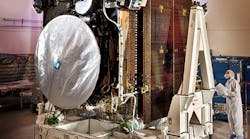Lockheed Martin, Northrop Grumman, and TeleCommunications Systems signed off on a review of the Advanced Extremely High Frequency (AEHF) satellite's security elements.
The review validated the design of the low-cost terminal (LCT), which is designed to provide secure communications to mobile military forces. With the review done, the defense contractors can start building hardware and software for the terminal's end cryptographic unit (ECU).
AEHF satellites are capable of providing jam-resistant communications to military forces on the move. But the extremely high frequency terminals carried by soldiers now are not widely available due to size and cost. Without more affordable terminals, soldiers will continue to rely on the Wideband Global System, which is considered more vulnerable to cyber attacks.
The ECU will be added to a Protected Communications On-The-Move (P-COTM) terminal. The terminal is being configured with the XDR waveform to support mobile ground, maritime, and airborne communications. The ECU will be integrated with the existing antenna and RF systems of the P-COTM prototype.
Also under construction is a protected Secure Internet Protocol Router Network/Non-secure Internet Protocol Router (SIPR/NIPR) access-point (P-SNAP) terminal. This portable ground terminal contains P-COTM components to connect soldiers in remote areas beyond the line-of-sight. Supporting modular quick-change feeds, the P-SNAP terminal is backward compatible with SNAP operations in the Ku-band and Ka-band.
Three AEHF satellites are currently in orbit, providing almost ten times the capacity of the legacy Milstar satellites. The satellites are connected by a series of crosslinks, which relay signals between satellites directly instead of using ground stations. The uplinks and crosslinks between the satellites operate at 44 GHz and the downlinks at 20 GHz.
For security, the phased-array antennas in the satellites can change their radiation patterns to guard against potential signal jamming. The AEHF constellation, which is being developed by Lockheed Martin and Northrop Grumman, will eventually have six satellites.
An early prototype of the LCT terminal has been fully tested. The companies, which have split the development cost, plan to test the terminal with an AEHF satellite by the end of 2015.
